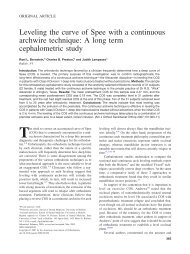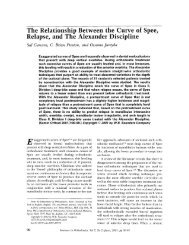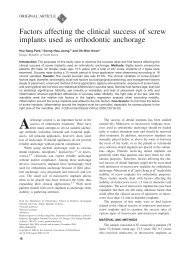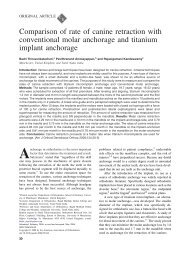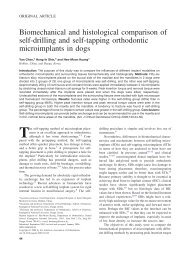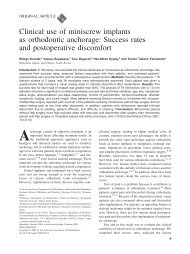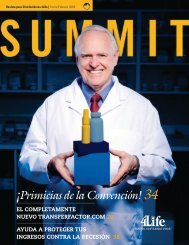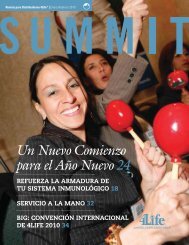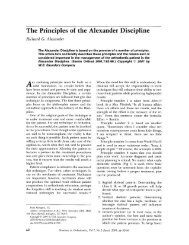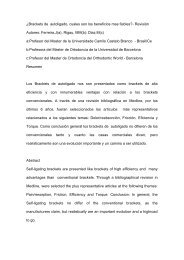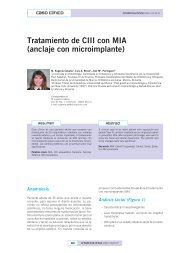Early treatment for Class II Division 1 malocclusion with the Twin ...
Early treatment for Class II Division 1 malocclusion with the Twin ...
Early treatment for Class II Division 1 malocclusion with the Twin ...
You also want an ePaper? Increase the reach of your titles
YUMPU automatically turns print PDFs into web optimized ePapers that Google loves.
ORIGINAL ARTICLE<br />
<strong>Early</strong> <strong>treatment</strong> <strong>for</strong> <strong>Class</strong> <strong>II</strong> <strong>Division</strong> 1<br />
<strong>malocclusion</strong> <strong>with</strong> <strong>the</strong> <strong>Twin</strong>-block appliance:<br />
A multi-center, randomized, controlled trial<br />
Kevin O’Brien, Jean Wright, Frances Conboy, Priscilla Appelbe, Linda Davies, Ivan Connolly, Laura Mitchell,<br />
Simon Littlewood, Nicola Mandall, David Lewis, Jonathan Sandler, Mark Hammond, Stephen Chadwick,<br />
Julian O’Neill, Ca<strong>the</strong>rine McDade, Mojtaba Oskouei, Badri Thiruvenkatachari, Michael Read,<br />
Stephen Robinson, David Birnie, Alison Murray, Iain Shaw, Nigel Harradine, and Helen Worthington<br />
Manchester, United Kingdom<br />
Introduction: The aim of this study was to evaluate <strong>the</strong> effectiveness of early orthodontic <strong>treatment</strong> <strong>with</strong> <strong>the</strong><br />
<strong>Twin</strong>-block appliance <strong>for</strong> <strong>the</strong> <strong>treatment</strong> of <strong>Class</strong> <strong>II</strong> <strong>Division</strong> 1 <strong>malocclusion</strong>. This was a multi-center, randomized,<br />
controlled trial <strong>with</strong> subjects from 14 orthodontic clinics in <strong>the</strong> United Kingdom. Methods: The study included<br />
174 children aged 8 to 10 years <strong>with</strong> <strong>Class</strong> <strong>II</strong> <strong>Division</strong> 1 <strong>malocclusion</strong>; <strong>the</strong>y were randomly allocated to<br />
receive <strong>treatment</strong> <strong>with</strong> a <strong>Twin</strong>-block appliance or to an initially untreated control group. The subjects were <strong>the</strong>n<br />
followed until all orthodontic <strong>treatment</strong> was completed. Final skeletal pattern, number of attendances, duration<br />
of orthodontic <strong>treatment</strong>, extraction rate, cost of <strong>treatment</strong>, and <strong>the</strong> child’s self-concept were considered.<br />
Results: At <strong>the</strong> end of <strong>the</strong> 10-year study, 141 patients ei<strong>the</strong>r completed <strong>treatment</strong> or accepted <strong>the</strong>ir occlusion.<br />
Data analysis showed that <strong>the</strong>re was no differences between those who received early <strong>Twin</strong>-block <strong>treatment</strong><br />
and those who had 1 course of <strong>treatment</strong> in adolescence <strong>with</strong> respect to skeletal pattern, extraction rate, and<br />
self-esteem. Those who had early <strong>treatment</strong> had more attendances, received <strong>treatment</strong> <strong>for</strong> longer times, and<br />
incurred more costs than <strong>the</strong> adolescent <strong>treatment</strong> group. They also had significantly poorer final dental occlusion.<br />
Conclusions: <strong>Twin</strong>-block <strong>treatment</strong> when a child is 8 to 9 years old has no advantages over <strong>treatment</strong><br />
started at an average age of 12.4 years. However, <strong>the</strong> cost of early <strong>treatment</strong> to <strong>the</strong> patient in terms of attendances<br />
and length of appliance wear is increased. (Am J Orthod Dentofacial Orthop 2009;135:573-9)<br />
We report <strong>the</strong> results of a 10-year randomized<br />
controlled trial examining <strong>the</strong> effectiveness<br />
of early orthodontic <strong>treatment</strong> <strong>with</strong> <strong>the</strong><br />
<strong>Twin</strong>-block appliance. Over <strong>the</strong> past few years, <strong>the</strong>re<br />
has been considerable debate on <strong>the</strong> merits of early orthodontic<br />
<strong>treatment</strong> <strong>for</strong> <strong>Class</strong> <strong>II</strong> <strong>Division</strong> 1 <strong>malocclusion</strong>s.<br />
When a young child <strong>with</strong> a severe <strong>Class</strong> <strong>II</strong> <strong>malocclusion</strong><br />
comes <strong>for</strong> assessment just after <strong>the</strong> eruption of <strong>the</strong> permanent<br />
incisors, orthodontists have a dilemma. This was<br />
succinctly put by Tulloch et al, 1 who asked ‘‘does <strong>treatment</strong><br />
started in <strong>the</strong> mixed dentition be<strong>for</strong>e adolescence<br />
[early <strong>treatment</strong>], when followed by a second phase of<br />
<strong>treatment</strong> in <strong>the</strong> early permanent dentition during adolescence,<br />
provide superior results to single-phase <strong>treatment</strong><br />
From <strong>the</strong> United Kingdom <strong>Class</strong> <strong>II</strong> study group, School of Dentistry, University<br />
of Manchester, Manchester, United Kingdom.<br />
Supported by <strong>the</strong> Medical Research Council (G9410454).<br />
The authors report no commercial, proprietary, or financial interest in <strong>the</strong> products<br />
or companies described in this article.<br />
Reprint requests to: Kevin O’Brien, School of Dentistry, University of Manchester,<br />
Higher Cambridge Street, Manchester M15 6FH, United Kingdom; e-mail,<br />
Kevin.O’Brien@manchester.ac.uk.<br />
Submitted, June 2007; revised and accepted, October 2007.<br />
0889-5406/$36.00<br />
Copyright Ó 2009 by <strong>the</strong> American Association of Orthodontists.<br />
doi:10.1016/j.ajodo.2007.10.042<br />
delayed until adolescence [adolescent <strong>treatment</strong>]?’’ The<br />
proponents of early <strong>treatment</strong> stated that it normalizes<br />
<strong>the</strong> skeletal pattern and reduces <strong>the</strong> length of adolescent<br />
<strong>treatment</strong> in <strong>the</strong> permanent dentition. However, recent<br />
research in <strong>the</strong> United States suggested that few benefits<br />
are gained by this approach. 1,2<br />
Although <strong>the</strong>se studies used high levels of scientific<br />
investigation and were carried out rigorously, <strong>the</strong> findings<br />
have not been universally accepted. The methodology<br />
was criticized because <strong>the</strong> studies were done in<br />
single dental schools, <strong>with</strong> 1 to 4 operators, and <strong>the</strong> patients<br />
were recruited from screening exercises and<br />
offered incentives to cooperate <strong>with</strong> <strong>treatment</strong>. This<br />
issue was addressed, to a degree, in our articles on <strong>the</strong><br />
first phase of our multi-center randomized trial about<br />
early <strong>treatment</strong> <strong>with</strong> <strong>the</strong> <strong>Twin</strong>-block appliance. 3,4 The<br />
results showed that early <strong>treatment</strong> was effective and<br />
resulted in a reduction in overjet, a small amount of<br />
skeletal change, and an improvement in <strong>the</strong> child’s<br />
self-esteem. Although <strong>the</strong>se results were encouraging,<br />
<strong>the</strong>y must be considered to be interim findings because<br />
<strong>the</strong> ultimate evaluation of early <strong>treatment</strong> should be<br />
after all orthodontic <strong>treatment</strong>, including <strong>treatment</strong><br />
during adolescence. This was <strong>the</strong> aim of this study.<br />
573
574 O’Brien et al American Journal of Orthodontics and Dentofacial Orthopedics<br />
May 2009<br />
MATERIAL AND METHODS<br />
The <strong>treatment</strong> that we studied can be defined as ei<strong>the</strong>r<br />
early or adolescent <strong>treatment</strong>. <strong>Early</strong> <strong>treatment</strong> is<br />
provided in 2 phases. The first is done when <strong>the</strong> child<br />
is in <strong>the</strong> transitional dentition. There is usually a period<br />
of inactivity followed by a final course of <strong>treatment</strong><br />
when most or all of <strong>the</strong> permanent dentition has been<br />
established.<br />
Adolescent <strong>treatment</strong> is <strong>treatment</strong> provided in 1<br />
stage when most or all of <strong>the</strong> permanent dentition has<br />
been established; it is carried out <strong>with</strong> functional or<br />
fixed appliances. This group was <strong>the</strong> control group in<br />
our study. Under <strong>the</strong> study conditions, <strong>the</strong>se patients<br />
could start <strong>treatment</strong> after a minimum of 15 months<br />
<strong>with</strong>out <strong>treatment</strong>.<br />
Thus, <strong>the</strong> only difference between <strong>the</strong> 2 groups was<br />
an earlier course of <strong>Twin</strong>-block functional appliance<br />
<strong>treatment</strong> when <strong>the</strong> child was in <strong>the</strong> mixed dentition.<br />
This investigation had <strong>the</strong> following null hypo<strong>the</strong>ses.<br />
There are no differences after all <strong>treatment</strong> between<br />
early or adolescent <strong>treatment</strong> <strong>with</strong> respect to (1) <strong>the</strong> anteroposterior<br />
relationship of <strong>the</strong> maxilla to <strong>the</strong> mandible,<br />
(2) <strong>the</strong> overjet, (3) <strong>the</strong> dental <strong>malocclusion</strong> as<br />
recorded by <strong>the</strong> peer assessment rating (PAR), (4) <strong>the</strong><br />
child’s self-esteem, (5) <strong>the</strong> process of <strong>treatment</strong> in terms<br />
of duration of orthodontic appliance wear and number<br />
of attendances at <strong>the</strong> clinic, and (6) <strong>the</strong> cost of <strong>treatment</strong>.<br />
Fourteen hospital-based orthodontic specialists in<br />
<strong>the</strong> United Kingdom took part in <strong>the</strong> study. Each one<br />
had undergone basic specialty training followed by<br />
a 3-year period of fur<strong>the</strong>r training in <strong>the</strong> <strong>treatment</strong> of severe<br />
<strong>malocclusion</strong>s. All operators were based in <strong>the</strong>ir<br />
own orthodontic department in <strong>the</strong> National Health Service<br />
of <strong>the</strong> United Kingdom. In this system, orthodontists<br />
receive a salary, and <strong>treatment</strong> is provided at no<br />
direct cost to <strong>the</strong> patient and <strong>the</strong> family.<br />
We based our sample size calculation on data from<br />
<strong>the</strong> University of North Carolina investigation. 5 This<br />
showed that <strong>the</strong> mean duration of <strong>treatment</strong> <strong>for</strong> patients<br />
who had later <strong>treatment</strong> after early <strong>treatment</strong> was 25<br />
months (SD, 11). It was decided that a meaningful difference<br />
between <strong>the</strong> <strong>treatment</strong> duration <strong>for</strong> children who<br />
did, or did not, receive early <strong>treatment</strong> was 6 months. To<br />
give a study a power of 80% and an alpha of 0.05, <strong>the</strong><br />
sample size needed to be 60 in each group.<br />
We used inclusion criteria of a minimum of 7 mm<br />
overjet (measured clinically), no craniofacial syndromes,<br />
and willingness of <strong>the</strong> patient and a parent to<br />
participate in <strong>the</strong> study. The patients had to be in <strong>the</strong><br />
mixed dentition <strong>with</strong> at least <strong>the</strong> permanent incisors<br />
and first molars erupted, but <strong>the</strong>re was no age criterion.<br />
These criteria were similar to those used in <strong>the</strong> North<br />
Carolina study of early <strong>Class</strong> <strong>II</strong> <strong>treatment</strong>. 1 We followed<br />
<strong>the</strong> guidelines in <strong>the</strong> Declaration of Helsinki. 6<br />
When patients who satisfied <strong>the</strong> inclusion criteria attended<br />
<strong>the</strong> clinic, <strong>the</strong>y were asked to take part in <strong>the</strong> investigation.<br />
If <strong>the</strong>y consented, <strong>the</strong> orthodontist phoned<br />
<strong>the</strong> study center at Manchester University to provide details<br />
of <strong>the</strong> patient. After initial recording of <strong>the</strong> patient’s<br />
data, he or she was randomized to receive early <strong>treatment</strong><br />
<strong>with</strong> a <strong>Twin</strong>-block appliance (early <strong>treatment</strong> group) or<br />
to have <strong>treatment</strong> delayed <strong>for</strong> a minimum of 15 months<br />
from entry into <strong>the</strong> study (adolescent group). The randomization<br />
was prepared by minimization stratified on<br />
center and sex. Trial registration started in October 1996.<br />
Treatment protocols<br />
A modification of <strong>the</strong> <strong>Twin</strong>-block appliance, originally<br />
developed by Clark, was used in this study. 7<br />
This appliance consisted of maxillary and mandibular<br />
removable appliances retained <strong>with</strong> 0.7-mm Adams<br />
clasps on <strong>the</strong> first permanent molars and 0.9-mm ball<br />
clasps placed in <strong>the</strong> mandibular incisor embrasures. A<br />
passive maxillary labial bow was also used to aid anterior<br />
retention and control <strong>the</strong> incisors if <strong>the</strong>y were<br />
proclined. The jaw registration was taken <strong>with</strong> approximately<br />
7 to 8 mm of protrusion and <strong>the</strong> blocks 7 mm<br />
apart in <strong>the</strong> buccal segments. The steep inclined planes<br />
interlocked at about 70 to <strong>the</strong> occlusal plane. When<br />
necessary, compensatory lateral expansion of <strong>the</strong> maxillary<br />
arch was achieved <strong>with</strong> an expansion screw that<br />
was turned once a week. Reactivation of <strong>the</strong> blocks<br />
was carried out when necessary. All patients were instructed<br />
to wear <strong>the</strong> appliance <strong>for</strong> 24 hours a day (except<br />
<strong>for</strong> contact sports and swimming). They were asked to<br />
wear <strong>the</strong> appliance while eating.<br />
When <strong>the</strong> patient’s overjet had been fully reduced,<br />
he or she continued to wear <strong>the</strong> appliance as a retainer<br />
at night only or was fitted <strong>with</strong> a retainer <strong>with</strong> a steep inclined<br />
biteplane according to <strong>the</strong> operator’s preference. 7<br />
The duration of this retention depended on <strong>the</strong> patient’s<br />
cooperation and <strong>the</strong> operator’s preference.<br />
The patients in both groups were <strong>the</strong>n kept under review<br />
in <strong>the</strong> clinics until <strong>the</strong> permanent dentition was<br />
more established and <strong>the</strong>y were ready <strong>for</strong> any fur<strong>the</strong>r<br />
<strong>treatment</strong>. This was <strong>the</strong>n provided according to <strong>the</strong> operators’<br />
normal <strong>treatment</strong> protocols. No fur<strong>the</strong>r randomization<br />
was carried out.<br />
Data collection<br />
Data were collected on <strong>the</strong> patients at <strong>the</strong> following<br />
points. Data collection 1 was when <strong>the</strong>y entered <strong>the</strong><br />
study. Data collection 2 was when <strong>the</strong>ir final appliances<br />
were removed.
American Journal of Orthodontics and Dentofacial Orthopedics O’Brien et al 575<br />
Volume 135, Number 5<br />
The following data were collected by each orthodontist<br />
and sent to <strong>the</strong> study coordinating center in<br />
Manchester: study models of <strong>the</strong> teeth, cephalometric<br />
radiographs, <strong>the</strong> patient’s self-esteem as measured by<br />
<strong>the</strong> Piers-Harris self-concept scale, <strong>the</strong> patient’s <strong>treatment</strong><br />
record, intraoral and extraoral photographs, and<br />
<strong>the</strong> patient’s zip code (used to determine socioeconomic<br />
status according to <strong>the</strong> Carstairs index 8 ).<br />
The cephalograms were analyzed <strong>with</strong> <strong>the</strong> Pancherz<br />
analysis. 9 The study casts were scored <strong>with</strong> <strong>the</strong> PAR<br />
<strong>with</strong> <strong>the</strong> United Kingdom weightings. 10 The cephalograms<br />
and <strong>the</strong> study casts were scored <strong>with</strong> <strong>the</strong> examiner<br />
unaware of <strong>the</strong> patient’s group. The examiner<br />
rescored 30 radiographs and study casts. The intraclass<br />
correlation coefficient was 0.9 <strong>for</strong> <strong>the</strong> PAR data. 11 The<br />
intraclass correlation coefficients <strong>for</strong> <strong>the</strong> cephalometric<br />
data ranged from 0.8 to 0.95, and <strong>the</strong> root mean squared<br />
ranged from 0.5 mm <strong>for</strong> A/OLp to 0.7 mm <strong>for</strong> Pg/OLp.<br />
These were acceptable levels of error.<br />
Treatment process<br />
Each patient record was examined, and we recorded<br />
<strong>the</strong> number of attendances and <strong>the</strong> appliances used,<br />
whe<strong>the</strong>r <strong>the</strong> patient completed all <strong>treatment</strong>, and<br />
whe<strong>the</strong>r extraction of permanent teeth was required<br />
during <strong>treatment</strong>.<br />
All data were entered into computer databases by research<br />
assistants who were unaware of group allocation.<br />
Incidence of trauma<br />
The incidence of trauma to <strong>the</strong> incisors during <strong>the</strong><br />
study period was recorded from a combination of examining<br />
data collection sheets, patient records, and anterior<br />
photographs and radiographs. We simply recorded<br />
whe<strong>the</strong>r trauma had occurred that had harmed <strong>the</strong> teeth;<br />
this was defined as visible signs of trauma—eg, a crack<br />
to <strong>the</strong> enamel or a dentin fracture. This was a simplified<br />
version of <strong>the</strong> method used in a similar trial. 12 A sample<br />
of 30 sets of records was reexamined, and reproducibility<br />
was calculated <strong>with</strong> <strong>the</strong> kappa statistic. 13 This gave<br />
a kappa score of 0.95, which is a high level of agreement.<br />
Cost analysis<br />
A cost analysis was carried out from <strong>the</strong> perspectives<br />
of <strong>the</strong> health care provider (National Health Service)<br />
and <strong>the</strong> children in <strong>the</strong> study. Data were<br />
collected from <strong>the</strong> start to <strong>the</strong> end of all <strong>treatment</strong>. We<br />
included data on scheduled and unscheduled clinic attendances,<br />
and data on both <strong>the</strong> distance traveled and<br />
<strong>the</strong> travel time <strong>for</strong> each child. We <strong>the</strong>n calculated <strong>the</strong><br />
costs using <strong>the</strong> following in<strong>for</strong>mation.<br />
1. The clinic attendances were costed by using <strong>the</strong><br />
national average cost per visit of $257 <strong>for</strong> <strong>the</strong> first<br />
visit and $147 <strong>for</strong> subsequent visits, according to<br />
<strong>the</strong> Department of Health reference costs. 14 These<br />
unit costs included staff, overhead, equipment and<br />
facilities, and <strong>treatment</strong>. Costs were discounted at<br />
3.5%. 15 The costs of travel were estimated at<br />
$0.31, which is <strong>the</strong> national average cost <strong>for</strong> public<br />
transport per kilometer. 16<br />
2. The time costs were estimated as <strong>the</strong> national average<br />
(median) pay per hour (Office of National Statistics).<br />
17 The travel and time costs included only<br />
<strong>the</strong> costs <strong>for</strong> <strong>the</strong> child. However, some children<br />
had traveled <strong>with</strong> at least 1 family member, but<br />
data on <strong>the</strong> proportion of children traveling <strong>with</strong><br />
an adult were unavailable. This meant that <strong>the</strong><br />
time and travel costs <strong>for</strong> <strong>the</strong> patient were a minimum<br />
estimate of <strong>the</strong> likely costs in routine practice.<br />
The costs were estimated in United Kingdom pounds<br />
sterling <strong>for</strong> <strong>the</strong> year 2005/06 and converted to US dollars<br />
by using purchasing-power parities <strong>for</strong> 2005/06. 18<br />
Statistical analysis<br />
We decided that <strong>the</strong> data analysis should be restricted<br />
to a few variables to reduce <strong>the</strong> chance of false<br />
positives and o<strong>the</strong>r spurious findings resulting from<br />
multiple comparisons across many related cephalometric<br />
variables. As a result, <strong>the</strong> data analysis was restricted<br />
to generation of descriptives and regression analyses of<br />
<strong>the</strong> following: (1) <strong>the</strong> relationship of <strong>the</strong> maxilla to <strong>the</strong><br />
mandible measured <strong>with</strong> <strong>the</strong> Pancherz analysis (Pg/<br />
OLp minus A/OLp), (2) <strong>the</strong> final overjet derived from<br />
<strong>the</strong> Pancherz analysis, 9 (3) <strong>the</strong> final PAR score, (4) <strong>the</strong><br />
Piers-Harris self-esteem score, (5) <strong>the</strong> process of <strong>treatment</strong>,<br />
(6) <strong>the</strong> incidence of extractions, (7) <strong>the</strong> incidence<br />
of trauma, and (8) <strong>the</strong> cost of <strong>treatment</strong>.<br />
We carried out an intention-to-treat analysis, so that<br />
<strong>the</strong> data from all patients, regardless of <strong>treatment</strong> outcome,<br />
were included. This comprised an analysis of<br />
all patients who entered <strong>the</strong> trial and <strong>for</strong> whom baseline<br />
and final records were available. There were some missing<br />
Carstairs and PAR baseline data because of imperfect<br />
models. We imputed <strong>the</strong>se data using baseline<br />
mean values as described by White and Thompson. 19<br />
The <strong>treatment</strong> effects <strong>for</strong> <strong>the</strong> continuous outcomes<br />
were estimated by regression (analysis of covariance,<br />
ANCOVA) models allowing <strong>for</strong> <strong>treatment</strong> center, age<br />
at baseline, age at start of second period, sex, socioeconomic<br />
status (Carstairs), and baseline value when appropriate.<br />
The baseline PAR score was also included<br />
in <strong>the</strong> models <strong>for</strong> attendance, duration of <strong>treatment</strong>,<br />
and cost. Logistic regression models were fitted <strong>for</strong>
576 O’Brien et al American Journal of Orthodontics and Dentofacial Orthopedics<br />
May 2009<br />
Assessed <strong>for</strong><br />
eligibility<br />
194<br />
<strong>Early</strong><br />
<strong>treatment</strong><br />
Randomized<br />
174<br />
Adolescent<br />
<strong>treatment</strong><br />
<strong>Early</strong><br />
<strong>treatment</strong><br />
89<br />
Adolescent<br />
<strong>treatment</strong><br />
85<br />
Lost to<br />
study:<br />
N=1<br />
14 dropped<br />
out of<br />
<strong>treatment</strong><br />
<strong>the</strong> binary outcomes of whe<strong>the</strong>r <strong>the</strong> child had extractions<br />
and new dental trauma to estimate <strong>the</strong> <strong>treatment</strong><br />
effect <strong>with</strong> <strong>the</strong> same covariables as above, including<br />
<strong>the</strong> baseline PAR score. Residual analyses assessed<br />
<strong>the</strong> assumptions about <strong>the</strong> use of multiple linear regression<br />
and logistic regression. We did not carry out pre<strong>treatment</strong><br />
univariate analysis of <strong>the</strong> variables that we<br />
measured, because this is not a currently recommended<br />
statistical practice. 20,21<br />
RESULTS<br />
One hundred seventy-four patients were enrolled at<br />
<strong>the</strong> start of <strong>the</strong> project; of <strong>the</strong>se, 89 (41 girls, 48 boys)<br />
were allocated to early <strong>treatment</strong>, and 85 (39 girls, 46<br />
boys) to later <strong>treatment</strong> (control). Enrollment started<br />
in March 1997 and was completed by August 1999. 3<br />
The last data collection was in July 2006. At <strong>the</strong> start<br />
of <strong>the</strong> study, <strong>the</strong> average ages of <strong>the</strong> children were 9.7<br />
years (SD, 0.98) <strong>for</strong> <strong>the</strong> early <strong>treatment</strong> group and 9.8<br />
years (SD, 0.94) <strong>for</strong> <strong>the</strong> adolescent <strong>treatment</strong> group.<br />
The flow of <strong>the</strong> patients through <strong>the</strong> study is shown in<br />
<strong>the</strong> Figure. Not all records had been collected <strong>for</strong> each<br />
patient; this is reflected in <strong>the</strong> number of subjects reported<br />
in <strong>the</strong> tables. These also show tha data loss was<br />
similar <strong>for</strong> both groups.<br />
75<br />
84<br />
Lost to<br />
study<br />
N=6<br />
13 accepted<br />
occlusion<br />
(10 all data<br />
collected)<br />
8 dropped out<br />
of<br />
<strong>treatment</strong><br />
(no data<br />
collected)<br />
5 dropped out<br />
of<br />
<strong>treatment</strong><br />
(no data<br />
collected)<br />
Part one of study Part two of study<br />
Fig. Flow of <strong>the</strong> patients through <strong>the</strong> study.<br />
54<br />
completed<br />
<strong>treatment</strong><br />
73<br />
completed<br />
<strong>treatment</strong><br />
Of <strong>the</strong> patients who had early <strong>Twin</strong>-block <strong>treatment</strong>,<br />
13 accepted <strong>the</strong>ir occlusion and declined fur<strong>the</strong>r <strong>treatment</strong>,<br />
whereas none of <strong>the</strong> control subjects accepted<br />
<strong>the</strong>ir occlusion after <strong>the</strong> 15-month period.<br />
The average ages at <strong>the</strong> start of <strong>treatment</strong> <strong>for</strong> <strong>the</strong> patients<br />
who had <strong>treatment</strong> in <strong>the</strong> permanent dentition<br />
were 12.1 years (SD, 1.0) <strong>for</strong> <strong>the</strong> adolescent group<br />
and 12.41 years (SD, 1.16) <strong>for</strong> <strong>the</strong> early <strong>treatment</strong><br />
group. Apart from <strong>the</strong> later start of <strong>treatment</strong> in <strong>the</strong> control<br />
group, <strong>the</strong>re were also some differences in <strong>the</strong> appliances<br />
used <strong>for</strong> <strong>the</strong> 2 groups. Of those treated early <strong>with</strong><br />
<strong>the</strong> <strong>Twin</strong>-block, 42 (64%) were subsequently treated<br />
<strong>with</strong> fixed appliances; only 6 (9%) were treated <strong>with</strong><br />
a fur<strong>the</strong>r <strong>Twin</strong>-block and fixed appliances, and 5 (8%)<br />
were treated <strong>with</strong> a fur<strong>the</strong>r <strong>Twin</strong>-block only. In <strong>the</strong><br />
adolescent <strong>treatment</strong> group, 45 (61%) were treated<br />
<strong>with</strong> <strong>Twin</strong>-block and fixed appliances, 14 (19%) <strong>with</strong><br />
fixed appliances only, and 14 (19%) <strong>with</strong> <strong>Twin</strong>-block<br />
only. Analysis of extractions showed that 27% of <strong>the</strong><br />
early <strong>treatment</strong> group and 37% of <strong>the</strong> adolescent <strong>treatment</strong><br />
group had extractions. However, this was not<br />
significantly different logistic regression model,<br />
<strong>treatment</strong> effect: odds ratio 1.32 (95% CI, 0.91-1.90),<br />
P 5 0.14.<br />
The cephalometric data are shown in Table I. For <strong>the</strong><br />
purpose of inclusion of uni<strong>for</strong>m data in systematic
American Journal of Orthodontics and Dentofacial Orthopedics O’Brien et al 577<br />
Volume 135, Number 5<br />
Table I. Descriptive cephalometric data be<strong>for</strong>e and after <strong>the</strong> study (Pancherz analysis 9 )<br />
<strong>Twin</strong>-block (n 5 63) Control (n 5 65)<br />
Be<strong>for</strong>e After Be<strong>for</strong>e After Treatment effect<br />
Mean (SD) Mean (SD) Mean (SD) Mean (SD) <strong>Twin</strong>-block – control (95% CI)<br />
Overjet 0.96 (0.31, 1.61)<br />
Is/OLp – ii/OLp 10.77 (2.47) 4.33 (2.19) 10.30 (2.45) 3.37 (1.42)<br />
Maxillary base –0.44 (–2.28, 1.40)<br />
A/OLp 70.19 (3.93) 74.02 (5.06) 70.84 (3.29) 74.46 (5.35)<br />
Mandibular base –2.15 (–4.63, 0.33)<br />
Pg/OLp 69.87 (5.04) 76.79 (7.20) 71.14 (4.54) 78.94 (6.84)<br />
Skeletal discrepancy –1.71 (–3.25, –0.18)<br />
(A/OLp – Pg/OLp) – 0.32 (3.18) 2.77 (4.54) 0.30 (3.03) 4.48 (4.14)<br />
Table <strong>II</strong>. Mean PAR scores (SD), Piers-Harris scores (SD), attendances in phases 1 and 2, and duration of <strong>treatment</strong> <strong>for</strong><br />
phases 1 and 2 <strong>for</strong> both groups of patients who had post<strong>treatment</strong> data<br />
reviews, we also included data using more conventional<br />
methods. The means (and standard deviations) <strong>for</strong> ANB<br />
angle at <strong>the</strong> end of <strong>the</strong> study were 4.0 (2.0) and 3.8<br />
(2.2) <strong>for</strong> <strong>the</strong> early and later <strong>treatment</strong> groups, respectively.<br />
The descriptive data on PAR scores, self-esteem,<br />
process, and costs of <strong>treatment</strong> are included in Table <strong>II</strong>,<br />
<strong>with</strong> <strong>the</strong> <strong>treatment</strong> effects from <strong>the</strong> regression models<br />
<strong>for</strong> all continuous primary outcomes shown in Table<br />
<strong>II</strong>I. There was no evidence from <strong>the</strong> residual analyses<br />
that <strong>the</strong> assumptions underlying <strong>the</strong> use of multiple linear<br />
regression and logistic regression were not upheld.<br />
The results suggest that, after all <strong>treatment</strong>, <strong>the</strong> only differences<br />
between <strong>the</strong> groups were <strong>treatment</strong> duration<br />
and final PAR score; <strong>the</strong>re were no differences in skeletal<br />
pattern and self-esteem. The early <strong>treatment</strong> group<br />
had significantly higher PAR scores at <strong>the</strong> end of <strong>treatment</strong><br />
(P 5 0.002). When we examined <strong>the</strong> process data,<br />
it appeared that <strong>the</strong> patients who had early <strong>treatment</strong> had<br />
<strong>Early</strong> <strong>treatment</strong> Adolescent <strong>treatment</strong><br />
n Mean (SD) n Mean (SD)<br />
PAR score Pre<strong>treatment</strong> 63 31.91 (9.13) 70 32.55 (7.85)<br />
Post<strong>treatment</strong> 10.25 (10.67) 6.30 (6.17)<br />
Piers-Harris score Pre<strong>treatment</strong> 62 60.33 (11.99) 70 61.78 (12.86)<br />
Post<strong>treatment</strong> 68.87 (8.32) 68.04 (10.09)<br />
Attendances in phase 1 (n) 66 11.48 (4.34) 72 None<br />
Attendances in phase 2 (n) 66 13.47 (5.54) 72 18.33 (8.44)<br />
Total attendances (n) 66 22.11 (9.00) 72 18.33 (8.44)<br />
Duration of <strong>treatment</strong> in phase 1 (d) 64 527 (208) 73 None<br />
Duration of <strong>treatment</strong> in phase 2 (d) 64 435 (344) 73 744 (397)<br />
Total duration of <strong>treatment</strong> (d) 64 968 (428) 73 744 (397)<br />
Total clinical cost of attendances (2005/06 $) 65 3282 (1131) 74 2398 (1123)<br />
Total travel cost of attendances (public transport) (2005/06 $) 65 105 (87) 73 136 (146)<br />
Total time cost of attendances (2005/06 $) 65 531 (322) 74 419 (280)<br />
Total costs (2005/06 $) 64 3913 (1388) 73 3018 (1400)<br />
statistically significantly fewer attendances in phase 2<br />
than did <strong>the</strong> adolescent <strong>treatment</strong> group (P \ 0.001),<br />
but when we combined <strong>the</strong>se <strong>with</strong> <strong>the</strong> visits that were<br />
necessary in phase 1, <strong>the</strong>y attended statistically significantly<br />
more times than did <strong>the</strong> adolescent <strong>treatment</strong><br />
group (P \ 0.016). Similarly, when <strong>the</strong> duration of<br />
<strong>treatment</strong> was evaluated, we found that <strong>the</strong> early <strong>treatment</strong><br />
group had statistically significantly longer overall<br />
<strong>treatment</strong> times than <strong>the</strong> adolescent <strong>treatment</strong> group (P<br />
\ 0.001). The cost of <strong>treatment</strong> was also greater (P \<br />
0.001) <strong>for</strong> <strong>the</strong> early <strong>treatment</strong> group; this additional<br />
cost averaged approximately $900.<br />
Eleven children experienced new dental trauma, 4<br />
(8%) in <strong>the</strong> early <strong>treatment</strong> group and 7 (14%) in <strong>the</strong> adolescent<br />
<strong>treatment</strong> group. This difference was not statistically<br />
significantly different logistic regression model,<br />
<strong>treatment</strong> effect: odds ratio 1.37 (95% CI, 0.70-2.72),<br />
P 5 0.36.
578 O’Brien et al American Journal of Orthodontics and Dentofacial Orthopedics<br />
May 2009<br />
Table <strong>II</strong>I. Treatment effects and 95% CI <strong>for</strong> <strong>the</strong> primary outcomes in <strong>the</strong> study, fitting <strong>the</strong> regression models, <strong>with</strong> ages<br />
at baseline and start of phase 2, sex, center, Carstairs index, and baseline value where appropriate, <strong>with</strong> <strong>the</strong> baseline<br />
PAR score included in <strong>the</strong> models <strong>for</strong> attendance<br />
DISCUSSION<br />
These results suggest that <strong>the</strong>re are minimal benefits<br />
of early ‘‘functional’’ or ‘‘growth modifying’’ <strong>treatment</strong><br />
in <strong>the</strong> transitional dentition. Treatment starting at this<br />
age simply increased <strong>the</strong> number of patient attendances,<br />
and <strong>the</strong> duration and <strong>the</strong> cost of <strong>treatment</strong>, and resulted<br />
in poorer final occlusion.<br />
This finding is similar to those of o<strong>the</strong>r studies that<br />
evaluated <strong>the</strong> effects of early <strong>treatment</strong>. In addition, it<br />
provides evidence of little difference in <strong>the</strong> effects of<br />
early <strong>treatment</strong> whe<strong>the</strong>r in ideal conditions in 1 dental<br />
school or in <strong>the</strong> real-world setting of specialist care in<br />
<strong>the</strong> United Kingdom. Fur<strong>the</strong>rmore, <strong>the</strong>re does not<br />
seem to be a difference in <strong>the</strong> results of similar studies<br />
involving <strong>treatment</strong> <strong>with</strong> <strong>the</strong> bionator and this study<br />
<strong>with</strong> <strong>the</strong> <strong>Twin</strong>-block. 1,2<br />
Although we can suggest that early <strong>treatment</strong> has<br />
limited advantages, we should consider <strong>the</strong> interim findings<br />
immediately after early <strong>treatment</strong>. These showed<br />
that early <strong>treatment</strong> results in reduction in overjet, favorable<br />
(but small) change in skeletal pattern, and<br />
meaningful improvement in <strong>the</strong> self-esteem of <strong>the</strong><br />
treated group. As clinicians, we must evaluate whe<strong>the</strong>r<br />
<strong>the</strong> additional course of <strong>treatment</strong> justifies <strong>the</strong>se interim<br />
changes that are not necessarily stable.<br />
A relevant finding was that 13 patients in <strong>the</strong> early<br />
<strong>treatment</strong> group declined fur<strong>the</strong>r <strong>treatment</strong>; <strong>the</strong>y were<br />
satisfied <strong>with</strong> <strong>the</strong>ir occlusion. Because we did an intention-to-treat<br />
analysis, and <strong>the</strong>y remained in <strong>the</strong> data<br />
analysis, <strong>the</strong>y did not influence <strong>the</strong> overall effectiveness<br />
of <strong>treatment</strong> <strong>for</strong> any analyzed variable. Never<strong>the</strong>less, we<br />
can conclude that 1 benefit of early <strong>treatment</strong> is that almost<br />
15% of <strong>the</strong> patients did not need more complex<br />
<strong>treatment</strong> in adolescence. Whe<strong>the</strong>r this justifies early<br />
<strong>treatment</strong> <strong>for</strong> a child <strong>with</strong> a <strong>Class</strong> <strong>II</strong> <strong>Division</strong> 1 <strong>malocclusion</strong><br />
can be determined by <strong>the</strong> patient, <strong>the</strong> parents,<br />
and <strong>the</strong> orthodontist.<br />
Treatment effect (SE) (adolescent,<br />
early <strong>treatment</strong>) 95% CI P value<br />
Skeletal discrepancy (n 5 127) 0.217 (0.312) –0.402, 0.835 0.489<br />
Overjet (n 5 127) –0.546 (0.175) –0.893 to –0.200 0.002<br />
PAR score (n 5 132) –2.329 (0.751) –3.819, –0.839 0.002<br />
Piers-Harris score (n 5 131) –0.919 (0.767) –2.439 to 0.606 0.23<br />
Attendances in phase 2 (n) (n 5 138) 3.843 (0.666) 2.526, 5.161 \0.001<br />
Total attendances in phases 1 and 2 (n) (n 5 138) –1.815 (0.739) –3.279, –0.351 0.016<br />
Duration of <strong>treatment</strong> in phases 1 and 2 (d) (n 5 136) –104 (32) –167, –41 \0.001<br />
Total clinical, travel, and time costs (2005/06 $) (n 5 138) –445 (139) –718, –171 0.001<br />
It was interesting to find clinical differences between<br />
<strong>the</strong> 2 groups in PAR scores, since <strong>the</strong> final occlusal<br />
result <strong>for</strong> <strong>the</strong> patients who received early <strong>treatment</strong><br />
was inferior to that of <strong>the</strong> adolescent group. When we<br />
compared this finding <strong>with</strong> ano<strong>the</strong>r clinical trial of early<br />
<strong>treatment</strong>, we found some differences between <strong>the</strong> studies.<br />
22 First, our patients’ pre<strong>treatment</strong> PAR scores were<br />
higher, suggesting greater severity of dental <strong>malocclusion</strong>.<br />
After <strong>treatment</strong>, our adolescent group had a score<br />
that was similar to those of studies in <strong>the</strong> United States;<br />
however, our early <strong>treatment</strong> group was not finished to<br />
such a high standard. 1,22 It is difficult to suggest reasons<br />
<strong>for</strong> this, since differences are unlikely in <strong>the</strong> operators’<br />
expertise in <strong>the</strong> 2 countries. One reason could arise from<br />
<strong>the</strong> different systems of payment in <strong>the</strong> United Kingdom,<br />
<strong>with</strong> care provided at no direct cost to <strong>the</strong> patient<br />
or <strong>the</strong> parent. It might be that payment influences <strong>the</strong><br />
motivation of US patients and that <strong>the</strong> early <strong>treatment</strong><br />
group maintained high levels of cooperation. In <strong>the</strong><br />
United Kingdom, <strong>the</strong> burden of 2 courses of <strong>treatment</strong><br />
might have caused patient burnout, and cooperation<br />
was lost. This, however, is purely conjecture.<br />
Most of <strong>the</strong> adolescent group also had a <strong>Twin</strong>-block<br />
functional appliance followed by fixed appliances; some<br />
of <strong>the</strong>se patients were also still in <strong>the</strong> late mixed dentition<br />
at <strong>the</strong> start of <strong>treatment</strong>. The differences in <strong>the</strong> results can<br />
<strong>the</strong>re<strong>for</strong>e be attributed largely to <strong>the</strong> older age at which<br />
<strong>the</strong> adolescent group started <strong>treatment</strong> ra<strong>the</strong>r than to<br />
a fundamentally different modality of <strong>treatment</strong>.<br />
Importantly, this and o<strong>the</strong>r studies provide in<strong>for</strong>mation<br />
that we should use as evidence to our patients on <strong>the</strong><br />
effects of <strong>treatment</strong>. They and <strong>the</strong>ir parents can now<br />
make an in<strong>for</strong>med decision on whe<strong>the</strong>r to undergo <strong>the</strong><br />
additional ef<strong>for</strong>t and cost of an earlier start of <strong>treatment</strong>,<br />
which necessitates a mid<strong>treatment</strong> pause and provides<br />
no long-term benefit, when compared <strong>with</strong> 1 course of<br />
<strong>treatment</strong> during adolescence.
American Journal of Orthodontics and Dentofacial Orthopedics O’Brien et al 579<br />
Volume 135, Number 5<br />
CONCLUSIONS<br />
From this multi-center, randomized, controlled trial<br />
using a contemporary functional appliance, we concluded<br />
<strong>the</strong> following.<br />
1. <strong>Early</strong> orthodontic <strong>treatment</strong> <strong>with</strong> <strong>the</strong> <strong>Twin</strong>-block<br />
appliance followed by fur<strong>the</strong>r <strong>treatment</strong> in adolescence<br />
at <strong>the</strong> appropriate time does not result in<br />
any meaningful long-term differences when compared<br />
<strong>with</strong> 1 course of <strong>treatment</strong> started in <strong>the</strong><br />
late mixed or early permanent dentition.<br />
2. There are definite disadvantages to <strong>the</strong> 2-phase approach<br />
including increased burdens <strong>for</strong> <strong>the</strong> patient<br />
in terms of attendance, costs, length of <strong>treatment</strong>,<br />
and an inferior final occlusal result.<br />
3. This study rein<strong>for</strong>ces similar conclusions of o<strong>the</strong>r<br />
randomized controlled trials. <strong>Early</strong> <strong>treatment</strong> <strong>for</strong><br />
<strong>Class</strong> <strong>II</strong> <strong>malocclusion</strong> is not normally justified.<br />
We thank <strong>the</strong> patients who took part in this study, <strong>the</strong><br />
supporting staff at <strong>the</strong> <strong>treatment</strong> centers, and Stephen<br />
Ward, Paul Cook, Dai Roberts Harry, and Yeweng<br />
Sanjie.<br />
REFERENCES<br />
1. Tulloch JFC, Proffit WR, Philips C. Outcomes in a 2-phase randomized<br />
clinical trial of early <strong>Class</strong> <strong>II</strong> <strong>treatment</strong>. Am J Orthod<br />
Dentofacial Orthop 2004;125:657-67.<br />
2. Dolce C, McGorray SP, Brazeau L, King GJ, Wheeler TT. Timing<br />
of <strong>Class</strong> <strong>II</strong> <strong>treatment</strong>: skeletal changes comparing 1-phase and 2phase<br />
orthodontic <strong>treatment</strong>. Am J Orthod Dentofacial Orthop<br />
2007;132:481-9.<br />
3. O’Brien K, Wright J, Conboy F, Sanjie Y, Mandall N,<br />
Chadwick S, et al. Effectiveness of early orthodontic <strong>treatment</strong><br />
<strong>with</strong> <strong>the</strong> <strong>Twin</strong>-block appliance: a multicenter, randomized, controlled<br />
trial. Part 1: dental and skeletal effects. Am J Orthod Dentofacial<br />
Orthop 2003;124:234-43.<br />
4. O’Brien K, Wright J, Conboy F, Chadwick S, Connolly I, Cook P,<br />
et al. Effectiveness of early orthodontic <strong>treatment</strong> <strong>with</strong> <strong>the</strong> <strong>Twin</strong>block<br />
appliance: a multicenter, randomized, controlled trial. Part<br />
2: psychosocial effects. Am J Orthod Dentofacial Orthop 2003;<br />
124:488-95.<br />
5. Tulloch JFC. Personal communication; April 19, 1994.<br />
6. Declaration of Helsinki. Available at: http://www.wma.net/e/<br />
poicy/17-c_.html. Accessed March 1, 1996.<br />
7. Clark WJ. <strong>Twin</strong>-block functional <strong>the</strong>rapy. London: Mosby-Wolfe;<br />
1995.<br />
8. Carstairs V. Multiple deprivation and health state. Community<br />
Med 1981;3:4-13.<br />
9. Pancherz H. The mechanism of <strong>Class</strong> <strong>II</strong> correction in Herbst<br />
appliance <strong>treatment</strong>. Am J Orthod 1982;82:104-13.<br />
10. Richmond S, Shaw WC, O’Brien KD, Buchanan R, Jones R,<br />
Stephens CD, et al. The development of <strong>the</strong> PAR index (peer assessment<br />
rating): reliability and validity. Eur J Orthod 1992;14:<br />
125-39.<br />
11. Fleiss JL, Slakter MJ, Fischman SL, Park MH, Chilton NW. Interexaminer<br />
reliability in caries trials. J Dent Res 1979;58:604-9.<br />
12. Koruluk LD, Tulloch JFC, Philips C. Incisor trauma and early<br />
<strong>treatment</strong> <strong>for</strong> <strong>Class</strong> <strong>II</strong> <strong>Division</strong> 1 <strong>malocclusion</strong>. Am J Orthod<br />
Dentofacial Orthop 2003;123:117-26.<br />
13. Landis JR, Koch GG. The measurement of observer agreement <strong>for</strong><br />
categorical data. Biometrics 1977;33:159-74.<br />
14. Department of Health. Reference costs 2005-06. Available at:<br />
(www.dh.gov.uk/en/Policyandguidance/Organisationpolicy/Finance<br />
andplanning/NHSreferencecosts/DH_074097). Accessed February<br />
2, 2007.<br />
15. National Institute <strong>for</strong> Clinical Excellence. Guide to <strong>the</strong> methods<br />
of technology appraisal no. 515. London: National Institute <strong>for</strong><br />
Clinical Excellence; 2004.<br />
16. Department of Transport. Transport statistics <strong>for</strong> Great Britain<br />
(TSGB) 2005. Available at: http://www.dft.gov.uk/pgr/statistics/<br />
datatablespublications/tsgb/. Accessed February 2, 2007.<br />
17. 2006 Annual Survey of Hours and Earnings (ASHE). Available<br />
at: www.statistics.gov.uk/StatBase/Product.asp?vlnk = (14630).<br />
Accessed February 2, 2007.<br />
18. Purchasing power parities. Available at: www.oecd.org/dataoecd/<br />
61/56/1876133.xls. Accessed February 2, 2007.<br />
19. White IR, Thompson SG. Adjusting <strong>for</strong> partially missing baseline<br />
measurements in randomized trials. Stat Med 2005;24:993-1007.<br />
20. Altman DG, Schulz KF, Moher D, Egger M, Davidoff F,<br />
Elbourne D, et al. The revised CONSORT statement <strong>for</strong> reporting<br />
randomized trials: explanation and elaboration. Ann Intern Med<br />
2001;134:663-94.<br />
21. Altman DG, Doré CJ. Randomisation and baseline comparisons in<br />
clinical trials. Lancet 1990;335:149-53.<br />
22. King GJ, McGorray SP, Wheeler TT, Dolce C, Taylor M. Comparison<br />
of peer assessment ratings (PAR) from 1-phase and 2-phase<br />
<strong>treatment</strong> protocols <strong>for</strong> <strong>Class</strong> <strong>II</strong> <strong>malocclusion</strong>s. Am J Orthod<br />
Dentofacial Orthop 2003;123:489-96.



